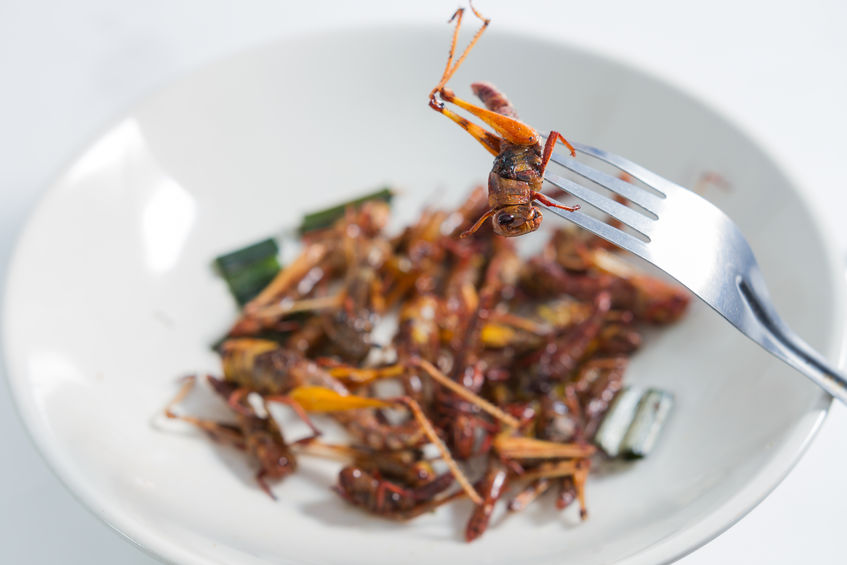By John Salak –
Reports from the oh, that’s simply disgusting front suggest that one of the great untapped food resources that may soon be finding its way into mouths everywhere is bugs. That’s right, everything from mealworms to crickets, scorpions, bees and beyond may soon be served up in a blender or on a nearby table in the coming months and years.
There’s apparently good reason for everyone to go buggy. Research from various universities and organizations increasingly see insects as an alternative source of protein for a world that is straining to meet food demands. Actually, engaging in entomophagy (that’s eating bugs) is nothing new for about 2 billion people. Insects, in fact, provide these people with a big dollop of their daily requirements for proteins, vitamins, minerals, and polyunsaturated fats, according to the United Nations.
Of course, most of these bug munchers don’t live in Europe, North America, Australia or similar regions where demand for insect-based cuisine is pretty slim. Change, however, may be coming out of necessity and perhaps shifting sensibilities. Researchers out of Indiana University-Purdue University Indianapolis (IUPUI) report that the overlooked yellow mealworm shows great promise as an alternative protein source.
The investigation into these mealworms was led by a specialist in the use of insects to address global food demand, Christine Picard, associate professor of biology and director in Forensic and Investigative Sciences program at IUPUI.
“Human populations are continuing to increase and the stress on protein production is increasing at an unsustainable rate, not even considering climate change,” she noted. “Mealworms, being insects, are a part of the natural diet of many organisms. Fish enjoy mealworms, for example. They could also be really useful in the pet food industry as an alternative protein source, chickens like insects — and maybe one day humans, too, because it’s an alternative source of protein.”
Mealworms aside, others are already pushing ahead with commercial applications of insect-based food products like Derek McCarty and Josh Campbell, cofounders of a startup called Human Improvement (HI). They are marketing a cricket-based protein powder that they believe will be eventually accepted by consumers.
HI’s protein powder mix is already available in numerous stores and through Amazon, but the founders readily admit that future demand will be drive my marketing.
“I’m always amazed that marketing is driving people to make bad decisions,” said McCarty. “Being ethical and responsible people, shouldn’t we be driving people to make good decisions with marketing?”
HI’s marketing answer focuses on sleek and colorful packaging that “jumps off the shelf,” especially when compared to the nondescript big tubs of protein powder usually seen in stores, according to Campbell.
Consumer reaction has been pronounced, if not unified. Campbell notes they’ve been hit with everything from “Oh my goodness, someone’s finally got it right” to “You guys have got to be crazy, no one’s ever going to buy this. We’re far more impressed with the positive response we’ve had.”
Protein powder is one thing. Ditto with ground up mealworms. But how about just munching on steamed or deep fried bugs? That’s an even tougher sell, admits Olympia Yarger, an insect farmer and founder of Insect Protein Association of Australia.
The problem isn’t taste, according to Yarger, who argues that crickets and scorpions (minus their poisonous stingers) can be quite appetizing if prepared properly. The issue is consumer psychology. People group things like crickets and scorpions together with cockroaches, dirt, grime and potential mouthfuls of uncooked goo.
Okay, that’s a turnoff for anyone and a really big challenge for the edible insect industry to overcome, no matter how nutritious and environmentally friendly bug consumption might be.
Yet Yarger argues, “they taste really great. But from a flavor profile the challenge the industry has right now is we’re not cooking them very well.” Don’t worry, he adds that “when crickets are prepared well, they taste like a cross between a cashew and a prawn cracker and like, those are the two best foods on the planet.”
Bug mania, admittedly, may still be years away for many consumers. But then again, it just may creep up on tables sooner than expected.













